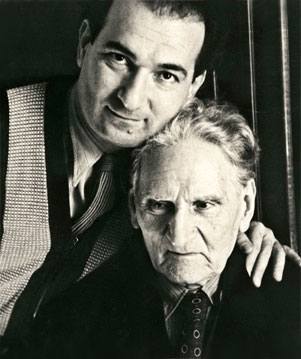| |
|
The main source of Martiros Sarian’s background happens to be his memoirs published as a separate book titled "From My Life" (the first edition appeared in 1966, edited by V.Matevosian). The book covers the artist’s first substantial period of life: from early childhood till 1928. The second period from 1929 till 1972 is presented in M.Kazarian and A.Agasyan’s book "Martiros Sarian. The Chronicle", published in 1980 on the occasion of the artist’s centenary, and also in the collection "About Sarian", compiled by A.Kamensky and Sh.Khachatrian. The artist’s biography is replenished with new details thanks to his letters edited by Rouzan Sarian – the House-Museum’s director (I volume: 1908-1928, printed in 2002; II volume: 1929-1953 printed in 2012, III volume is made ready for edition). |
| |
|
|
Martiros Sarian and his son kompozer Lazar Sarian, 1952
STORY OF A PICTURE
Self-Portrait. Three Ages, 1942
-
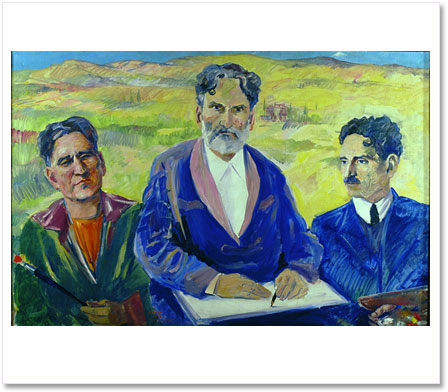
The self-portrait ‘Three Ages’ (1942) has a special place in the works of the artist. The principle characteristic to cinematograph when different time frames are united in one composition is employed here. The self-portrait is also created with the aim to reflect different periods of life. On the right Sarian depicted himself when he is romantic and dreamy, with rosy ideas about the future.
On the left we can see a middle-aged man who is exploring the world around him. In the centre of the picture a mature wise man is depicted, who is thinking about the life he’s past through. His penetrating look is directed at the viewer. An interesting thing is that the artist used his picture taken in 1910 to reflect his youth, and his ‘Self-portrait with mask’ (1933) to portray his middle age. All three portraits are executed against the background of Armenian landscape crowned with barely visible tops of Mt.Ararat.
Motherland, Armenia, home – these are the values that Sarian protected with his most powerful weapon: with art, inspiring his three images, his three ages.
-
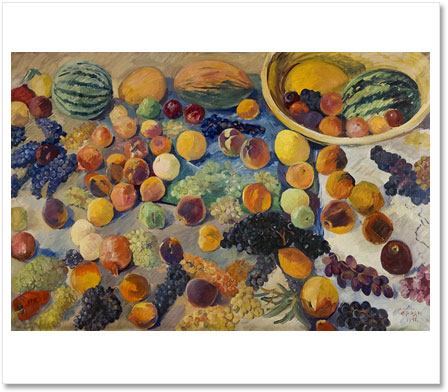
Still lives have a special place in Sarian’s art. On the House-Museum's second floor exhibition you can find two great still lives which were executed during the war years (‘Fruits’ – 1941 and ‘Autumn Still Life’ – 1944).
Sarian depicted rich and beautiful nature of Armenia, the results of people’s hard work. Despite the fact that there was a war, Sarian painted flowers and fruits, depicted beauty of life, its everlasting values, people’s peaceful work that was to be kept and protected. Sarian’s still lives created in the years of war are none the less lighthearted and full of life. Once again it proves the idea that only by living and creating you conquer the death.
Martiros Sarian,
From artist’s life. Portrait of L. Sarian, 1941
-
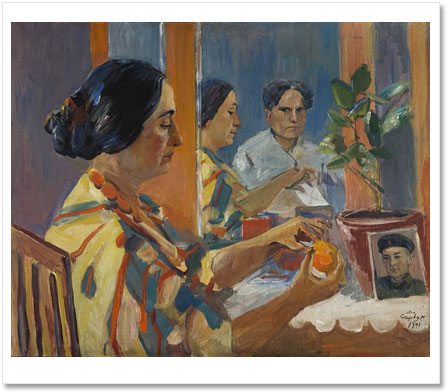
Here we see the painter’s anxiety about his son’s Lazar (Ghazaros) fate who was fighting in the battle field (World War II). His photo in a military uniform is clung to a flowerpot with a householding plant. In the foreground Sarian depicted his beloved wife Lusik who was holding an orange fruit in her hands. However in the mirror’s reflection one can see how the fruit held in the mother’s hands is transformed into a long –awaited letter from her son.
This is what the parents wait for and dream about (longing for good news from their son). This work is particularly interesting that by inserting in it the elements characteristic for cinematograph, Sarian as if expands opportunities of spatial-temporal unity of the easel painting. In this very case we see combination of real and imaginary, expectation and fact, present and future… This touching story created by the artist with the language of art has a happy ending: the painter’s son Ghazaros returned home after the war was over.
-

Biblical Ararat like a cupola is rising over the City in all of its might and splendor. Big and small cupolas of Zoravor church as if repeat the mount’s contours. Armenia’s nature carved mountains, and a Man repeated their forms in the churches’ architecture being the incarnation of faith, prayer and god worshipping. The picture’s pictorial structure is permeated with Sarian’s everlasting belief in sunlight triumph.
Although the day is hazy and Ararat is misty the painting’s foreground with trees and grazing under them horses is sunlit.
Yerevan courtyard in Spring, 1928
-
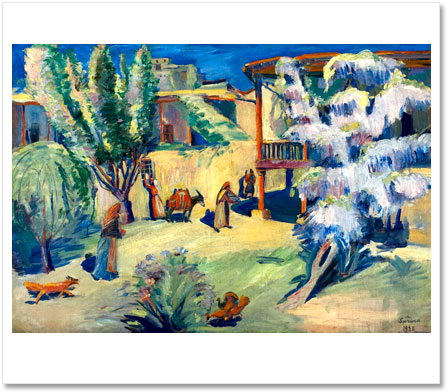
This painting was executed by Sarian after his return from Paris. It is a corner of old Yerevan with typical for national architecture two-story house with a wooden balcony overlooking a patio. Sarian’s notes where he describes such corner came down to us. ‘In 1924 we moved to a new place situated in Rubeni str., 55, where I finally could live and work with no worry. A small flower garden near the house, orchard and view from the porch – everything looked very picturesque.
In spring all surrounding territory would turn into a blooming garden. Wisteria flowers were exceptionally beautiful… Old attractive Yerevan houses gradually went to ruins, no one cared about them. They got deserted and with time collapsed. I regret I painted those scenes so rarely then'. Unfortunatly the house with patio is not in existence. In the painting the artist accentuates the plant of wisteria with its violet-blue flowers growing at the balcony.
Time and again the plant attracted Sarian’s attention by its beauty. Nowadays the 1910 ‘Wisteria’ executed by the artist in Constantinople is a gem of the Tretyakov gallery collection in Moscow.
-
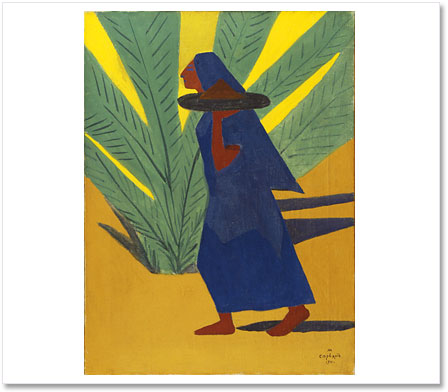
In 1911 Sarian visited Egypt. The artist was inspired by this oriental country whose ancient culture interested him from his youth up. The outcome of the visit was the execution of his famous series of paintings. In this cycle a special place is given to the depiction of Egyptian women, among them ‘Walking Woman’ is the most distinguished. As art critic Alexander Kamensky picturesquely expressed himself, ‘the figure’s face is represented in such a generalized manner that it seems to be a kind of hieroglyphic symbol for the human face’.
The position in profile clearly correlates with Egyptian frescos. Everything is extremely compact in the flat two-dimensional composition. The contrast of blue, yellowish-brown and green hues creates the maximum stress of color correlations. All is generalized up to maximum and some elements acquire symbolic meaning: fruit piled on the tray is associated with Pyramid and the Egyptian’s figure reminds Sphinx. Sarian’s memoirs suggest that idea: ‘On leaving the Museum of Bulakh one could see in the streets the people who seemed to have been models for the sculptures in the museum… It was striking and at once a bit frightening.
As if they had been wandering right through millennia and reached this day together with the fine monuments created by their ancestors at the dawn of civilization’
-
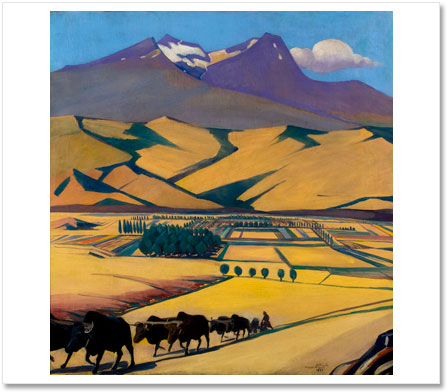
Sarian devoted much attention to the ploughman’s character. Being a son of the farmer, he had faced the difficulties of earning the bread from his childhood. The large-sized painting ‘Aragats’ seems to be the pictorial reflection of Armenian folk song ‘Horovel’. (Song of a ploughman).
The viewer can see a multi-aspect panorama with the violet mountain tops of monumental Mt. Aragats towering above the horizon. From the picture’s depth we see a ploughman with a plowshare in his hand and yoked oxen walking towards the viewer. With its basalt heaviness Aragats highlights hard and at the same time so vitally important and sacred labor of a plowman. The following words of Sarian are the key to the picture’s main idea: ‘ My aim is to reflect the tangible existence of our little country that has witnessed plenty of disasters and was repeatedly defiled but sanctified with blood and belief. This rocky piece of land on the slope of Aragats is a source of hope for me.
I want to show the world that this mountainous country exists and holds a small yet hard-working and talented nation with its ancient spiritual values, symbolizing its heroic history’.
-
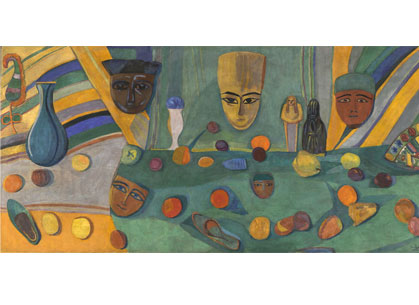
"Egyptian Masks" of 1915 has its special place among the other still lives created by Sarian. At first glance it is perceived as a kind of innovative art - a colorful decorative canvas. But the date of its creation, 1915 suggests that the artist expressed his thoughts and feelings as to the massacres in Western Armenia via this work.
The artist reflects sorrow and tears in the eyes of the mask in the upper left corner. There is another mask depicted in the bottom left corner with hardly visible smile of hope. In the top right corner there is one more mask reflecting wonder and anxiety with upraised eyebrows. And finally, in the center of the picture, a bright yellow mask, as if looking from the depth of centuries to the future with a hopeful look. Near the mask one can see a white vase with eternity symbol on top of it in the form of a blue ball.
This combination asserts the main and perspective idea the year 1915 is not the last date of the Armenian history, it is an ordeal, and that Armenians will definitely overcome it in order to continue their mission as one of the ancient nations of the world.
-
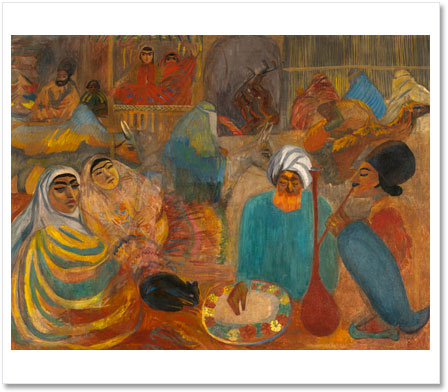
"In Tehran I did not see the motley crowd that was in Constantinople and Cairo", -wrote Sarian about his tour to Persia in 1913.’Both men and women were dressed in black. The whole city seemed to be in mourning. I couldn’t explain the Persians’ love to black color. As if all other colors were banished from the city. It was strange and inconceivable, as their beautiful miniatures were dazzling with a variety of nature’s colors and hues’.
Sarian noticed that ‘the market – motley and always boisterous was the only most interesting place in Persian towns. Here one could see squatting Persian tradesmen playing backgammon or smoking hookah. Very noticeable was the contrast between the market’s activity and the tradesmen’s indifferent faces. It was hard to believe these people to be engaged in trade. The faces of women sitting next to them resembled frozen masks. These characters were embodied in Sarian’s large painting – "Persia" where panorama of Tehran market is reflected.
-

In 1911 Sarian visited Egypt. The artist was inspired by this oriental country whose ancient culture interested him from his youth up. The outcome of the visit was the execution of his famous series of paintings. In this cycle a special place is given to the depiction of Egyptian women, among them "Walking Woman" is the most distinguished. As art critic Alexander Kamensky picturesquely expressed himself, ‘the figure’s face is represented in such a generalized manner that it seems to be a kind of hieroglyphic symbol for the human face’. The position in profile clearly correlates with Egyptian frescos. Everything is extremely compact in the flat two-dimensional composition.
The contrast of blue, yellowish-brown and green hues creates the maximum stress of color correlations.
All is generalized up to maximum and some elements acquire symbolic meaning: fruit piled on the tray is associated with Pyramid and the Egyptian’s figure reminds Sphinx. Sarian’s memoirs suggest that idea: ‘On leaving the Museum of Bulakh one could see in the streets the people who seemed to have been models for the sculptures in the museum… It was striking and at once a bit frightening. As if they had been wandering right through millennia and reached this day together with the fine monuments created by their ancestors at the dawn of civilization’
-
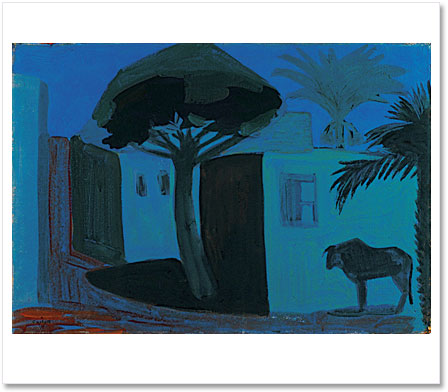
Painting ‘Night Landscape’ created by Sarian under the impressions of his travel to Egypt is the masterpiece among other works of his Eastern period. Usually Master’s works are sunlit but this landscape stands out by its unique moonlit atmosphere. While his other compositions are based on color contrasts, this one – on color nuances, smooth color transitions of blue, azure, turquoise and gray hues. Fantastic Egyptian night: the hamlet’s wattle and daub houses flooded with moonlight, a sleepy buffalo at the wall, and in the middle of the picture – a beautiful tree and a slender palm’s silhouette on the horizon. Thus the impression of harmony, tranquility and ‘vibrating’ silence is created. Sarian described in his memoirs the story of this landscape’s creation: ‘We were walking down along narrow crooked streets of my guide’s native village. The shadows of palm trees were reflected on the earthenware walls of the small houses. It was a real feast of colors and forms. Under these impressions I painted ‘Night in Egypt’.
Writing about this work an art historian Alexander Kamensky noticed: ‘Sarian’s depiction is absolutely real, but at the same time it looks as a wonderful vision and ‘a dream with open eyes’.
The Dogs of Constantinople, 1910 -

With the aim to learn more about the nature of the East and the lifestyle of people living there, Sarian went to Turkey, Constantinople (On February 26, 1910) where he stayed for two months and created his first masterpieces of the Eastern cycle.
‘The Dogs of Constantinople’ is the only pictorial work of this period finds its place in the collection of the M.Sarian house-museum. In his memoirs the artist wrote: ‘There was a rich material for the exploration of animals in Constantinople. The dogs lived here with family packs, each group in their certain area… Near them the Turkish men in loose pants and red fezes were walking and the women clad in chadors, tapping with their clogs also were passing by and children were running about.
Nobody was getting closer to the dogs’. In the picture’s foreground a picturesque group of fighting dogs is depicted. They are in a unique contrast with a merchant sitting at the show window, inhaling hookah lazily. The viewer’s look passes across the street to the woman wrapped in chador, walking up the street and to the donkey loaded with hay.
This episode and the occasional moment randomly taken from the everyday life of Constantinople provide the complete picture of the unique spirit of this city.
SELF-PORTTAIT - SKETCH, 1909 -
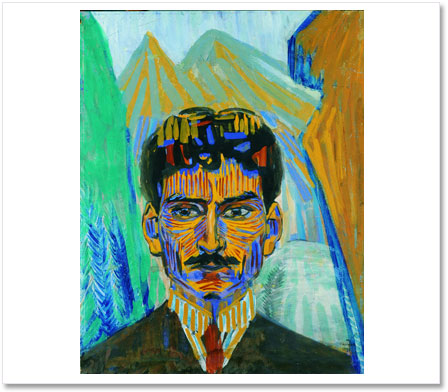
This a Sarian’s first pictorial ‘Self-Portrait’ created in 1909. It is the sketch of the ‘Self-Portrait’ executed in the same year and kept in the Tretyakov Gallery.
Sarian painted himself ‘walking through the valleys and mountains, in the sun, illuminated with the golden sun rays. S.I.Shchukin, a noted art connoisseur and collector of modern French paintings, on seeing Sarian’s masterpiece exclaimed: ‘It is wonderful.
You are a great portraitist’ and ordered his son’s portrait. The work is more than a self-portrait – this is rather an extremely generalized image of creative individual that accumulates in him the power of nature. Sarian uses expressive contrasting colors and paints with confidence with free and wide dabs. Both the self-portrait and mountains in the background are executed in the same manner. Thus the impression is created that a Man ‘sprouts out’ of the nature and that he is its continuation and integral part.
Only through human being nature can perceive itself. The unity of nature and a Man is the main pantheistic idea realized in the 1909 ‘Self-Portrait’.
By the well. Hot day, 1908 -
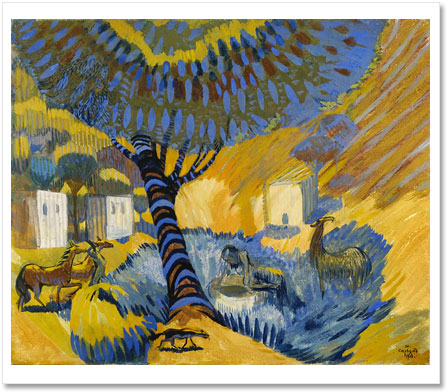
Sarian painted trees for his whole life. It feels like they hand down to us the rustle of the ‘Tree of Life’ planted by the Creator in the centre of Eden.
A tree placed in the middle of the picture’s composition embodies the idea of World Axis and all living creatures (including human beings) gather around it. The power of the trunk with its marked rings is perceived. The forces of Earth feeding the tree crown rush up to the trunk. At midday heat a fertile shadow is spread down the tree, creating an oasis of calmness and harmony.
People and animals are rushing here, seeking shelter from the glaring sunrays. The well is depicted in the shade of the tree. The woman’s figure that nearly merged with blue shadow bent over it.
All the painting’s palette is permeated with sun and color combinations are made up of yellow and dark blue, orange and purple. Every brushstroke is drastic and vigorous and this makes the painting even more expressive and beautiful.
-
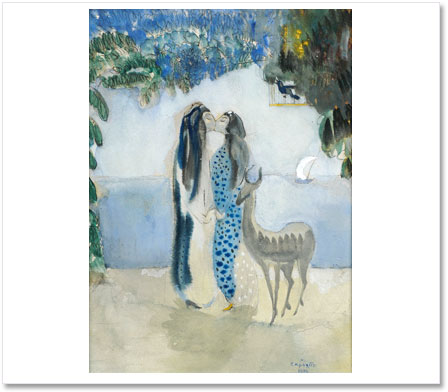
Love.FairyTale is the masterpiece among Sarian’s watercolor paintings titled Fairy Tales and Dreams(1904-1907). In 1903 after graduating from the Art College in Moscow, Sarian categorically broke off with the established rules of the Art school and tried to find other ways of self-expression. ‘After a number of nature sketches, I realized that I want to get rid of them and to give my imagination freedom to create ‘, - noted the painter. The world of fairy tales and dreams gave the artist the opportunity to express his feelings. The watercolor technique let him reproduce his most subtle emotions, to re-create exquisite color nuances, the vibration of the light and movement of air.
The man and the woman are merged with an eternal kiss. A gazelle is gently clung to them. In the distance the waves of the sea are flapping the boat. The whole composition is made up of the transitional hues from dark blue to light blue.
In 2003, together with other watercolor paintings of this period this work was presented at an exhibition organized in Picasso museum (France), and also in 2010 in Groninger museum (Holland) at the exhibition titled ‘The Unknown Orient of Russia’.
-
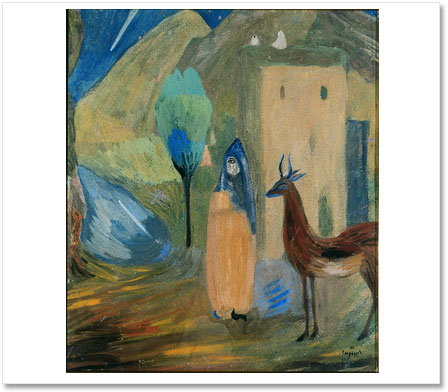
Martiros Sarian
This is Sarian’s most famous symbolic work. A one-eyed man is depicted in the centre of the composition.
He is like a generalized character of a philosopher, poet and sage with the power of his all-seeing eye to penetrate into the secrets of the Universe. Sarian managed to equalize flight of imagination with surrounding world reality.
‘The Comet’ is composed of the elements, inherent for Sarian’s art such as single-storey wattle and daub house, men’s figures sitting on its flat roof, mountains, trees, a gazelle, a pond with reflected night sky and comet. That is simple yet generalized picture of the world. Thus the artist achieves the most vivid and convincing juxtaposition of fairy tale and reality.
-
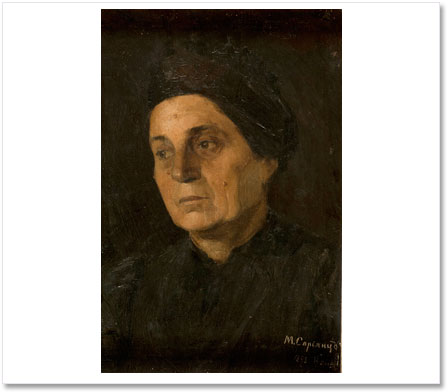
Martiros Sarian
The portrait was executed by Sarian during his student years. The painter’s palette corresponds to the portraiture established canons.
Although Sarian has not yet undertaken new pictorial tasks, the image projected by him suggests his tender and filial love for his mother – Ustiane. “My mother worked very hard. All day she was busy around the house: carried on the yoke pails with water from the well, fired a furnace, baked tasty bread and puffs, cooked dinner, milked, churned and made cheese.
She was in time for everything and was an expert in her field. When holding a child in her left hand, she could at the same time knead dough with her right hand.
Everything cooked and baked by our beauty, our kind and tireless mother was extremely tasty… She was brought up as a Christian and used to pray for people’s well-being, asking Lord to forgive her (the holy one) for the sins she had not committed.
She had scarcely had a minute’s rest and then she would read aloud her prayer-book in splendid old Armenian language.’
In the Grove of Sambek, 1909 -
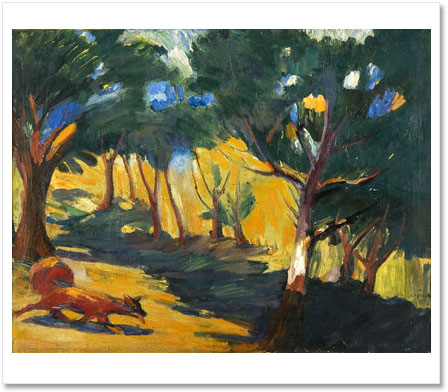
In his early period of creativity Sarian alongside with fairy-tale motifs also paid his attention to the real nature depiction. Landscape ‘In the Grove of Sambek’ is such a work.
In 1882, on the Sambek bank the painter’s father Sargis Sarian built a mud-brick house for his large family. The future artist spent his childhood there. The Sambek was not a full-flowing river and it used to shallow in sultry summertime and got covered with reed. For the first time in this work Sarian depicted his beloved red-haired dog – Polkan.
We know his name from Sarian’s notes. This foxlike dog also appears in his other later works, such as “Yerevan Courtyard in Spring’, ‘On the way to the Well’, ‘Fairy Tale’. The painting ‘In the Grove of Sambek’ testifies Sarian’s mature artistic manner and bright palette.
|
|


 STORY OF A PICTURE
STORY OF A PICTURE
